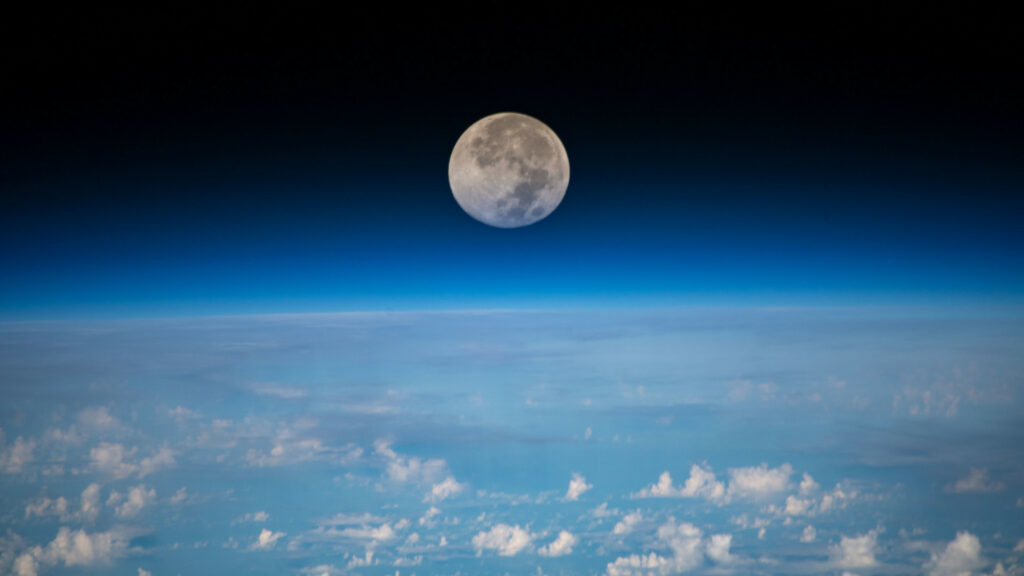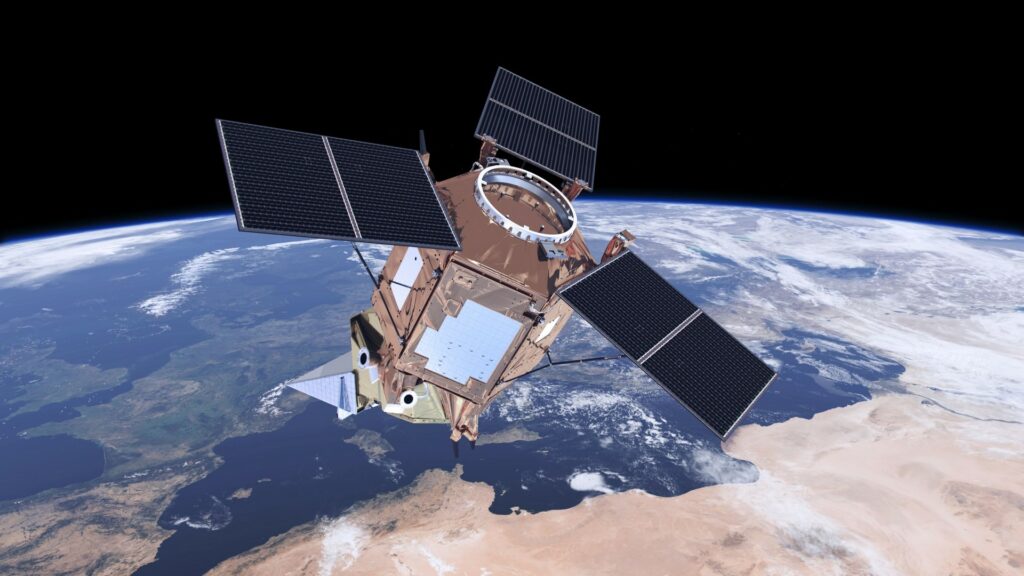
Space is the final frontier, we sometimes hear. But where exactly is this final frontier? Not everyone agrees on the answer to be given.
Where does space begin?
To this question, there is no definitive answer. More exactly: the answer will not be the same between an astronaut, a lawyer and a climatologist for example, and no one will necessarily be wrong. There is in fact no clear and indisputable border between space and the Earth’s atmosphere, but a gradual disappearance of the latter, as one moves away from Earth.
The Earth’s atmosphere is actually divided into several layers, called the troposphere, stratosphere, mesosphere, thermosphere and exosphere. For example, the International Space Station revolves around the Earth at about 400 kilometers above sea level and no one would think of saying that it is not in space. However, even at such a distance, there is still atmosphere!
” At 400 km there is a residual atmosphere, however, comprising around 100 million atoms and molecules. “, Recalls the National Center for Space Studies (Cnes). And yet, when Thomas Pesquet leaves the ISS to perform an intervention, he must be in a full suit to protect himself. Even though it is still technically in the atmosphere, space is already wreaking havoc on the human body at this height.

This envelope of gas that is the atmosphere is about 800 km thick, if we exclude the exosphere, which is the outermost layer (and which ends up dissipating in the “vacuum” of the cosmos over several tens of thousands of kilometers). Its density decreases as the altitude increases. In addition, the altitude at which each layer begins is not uniform all around the globe.
The point is that the altitude at which space begins is not legally defined. The space treaty, which dates from the mid-1960s, mentions outer space, without giving a clear definition (ditto in other UN documents): we do not speak of ” height ”,“ altitude ”or“ kilometers ”, which leaves room for uncertainty and interpretation.
In 2018, a working document prepared by the chairman of the legal subcommittee’s working group on the definition and delimitation of outer space noted a “ contradiction “:” outer space constitutes the vertical border of national territories which, although finite, extend from the surface of the Earth to an undetermined altitude “.
This same document produced within the Committee on the Peaceful Uses of Outer Space, which is attached to the United Nations Office for Outer Space Affairs, however suggested establishing by convention an internationally recognized border between airspace and the United Nations. outer space at an altitude of 100 km above mean sea level.
Why do we say that space begins at an altitude of 100 km?
This is an indication that we read in particular in the pages of Cnes intended for young people: ” scientifically, space is considered to begin at an altitude between 100 and 120 kilometers “. But why this height rather than another? And above all, why do we often find this mention of 100 kilometers when it comes to the delimitation between space and atmosphere?
It is in fact physical considerations which justify establishing the border towards these 100 km, and not for example at 800 km, just before the exosphere. Indeed, it is at this height that the aerodynamic phenomena – that is to say the flow of air and its effects on bodies, such as the wings of an airplane – are no longer sufficient to ensure the lift of an aircraft in flight.
” This altitude is located in a singular zone where the aerodynamic lift decreases to reach critical thresholds. “, Noted the UN working group. In fact, to stay in the air and not fall back (like satellites or the International Space Station), it is no longer on the aerodynamic lift that you have to rely, but on a sufficient speed to get into orbit. .

It is therefore because the aerodynamic forces are no longer applied correctly, due to the rarefaction of the air, that this particular elevation has been retained. It also bears a name: Kármán line, in homage to Theodore von Kármán, an American-Hungarian physicist who made major contributions in the field of aerodynamics in the mid-twentieth century.
The Kármán line is in fact an imaginary line established by convention. It turns out that Theodore von Kármán wondered at what altitude the atmosphere becomes so thin that it actually becomes a ceiling for aeronautics. In 1956, his calculations led to the altitude of 83.8 km. Except that it was decided not to retain this value, but to make a (big) rounding, to 100 km.
Since the Kármán line is a human invention indicating roughly where the aerodynamic forces go, and since there is no real physical boundary anyway, it did not seem absurd to opt for an easier value to remember. and to handle. This line has imposed itself: today it is generally considered to be the border between space and atmosphere.
This definition is for example accepted by the International Aeronautical Federation (FAI): this threshold is ” the benchmark that the FAI uses to differentiate between aeronautical and astronautical exploits ”, We read for example in a press release of 2005 on a record relating to space. But there is one notable exception: the United States. In their eyes, space begins a little lower.
Why does the USA have a different definition?
This American peculiarity has been known for a long time and, when Virgin Galactic embarked on space tourism, it returned to the forefront, particularly in 2018 and 2021. In fact, Virgin Galactic has exceeded the required altitude. by American standards, but not that commonly accepted in the rest of the world. Blue Origin, a competitor, did not fail to point this out.
Historical reasons have influenced the American orientations. The United States was one of the first nations in the world, along with the USSR, to attempt to go into space and to have the means to do so. Of course, he asked himself the question of knowing from what moment we entered, precisely, into space. And an answer was given in the 1950s, during the decade that Theodore von Kármán worked on this question.
This is what NASA says: ” the engineers decided to draw an arbitrary line at the altitude where the dynamic pressure was less than one pound per square foot, since traditional aerodynamic control surfaces would then be largely unnecessary “. This line was drawn a little above 80 km, that is to say a value quite close to that calculated by Theodore von Kármán.

” Although this altitude varies from day to day and from region to region due to weather conditions, it is typically around 50 miles (264,000 feet, or 81 kilometers) and marks approximately the end of the mesosphere », Adds NASA. This definition was then codified in military regulations to define at what altitude pilots become astronauts.
Another factor to be taken into account: the international system of units is not officially used across the Atlantic. It is especially that of imperial units that is common. However, if the USA had retained the altitude of 100 km, like everyone else, this would have given a value in miles impractical to remember and use (60, by rounding widely, or otherwise 62, by being a little more precise), since it is this unit which is current.
If the States have not (yet?) Agreed on the altitude to be used to separate the atmosphere from space, it turns out that even in America, there were differences of appreciation between NASA and the army. It was among the military that pilots were recruited and trained to become astronauts, like Alan Shepard and John Glenn. They are considered the pioneers.
While the US military reserves the term astronaut for anyone who has flown above 50 miles, NASA was considering retaining another height, 62 miles, closer to the Kármán line. She ended up lining up ” to eliminate any inconsistency between military and civilian pilots flying the same vehicle », And thus have a common basis for defining the status of astronaut.
Therefore, it is not at all certain that this limit will ever change: indeed, a definition based on a higher altitude, although more accepted internationally, runs the risk of downgrading some of these pioneers of the status of astronauts, such as William H. Dana and John B. McKay, who have flown above 50 miles, but never exceeded 62 miles (100 km).



